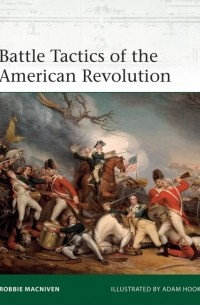
Автор
Robbie MacNiven — книжные серии
- 1 произведение
- 7 изданий на 2 языках
-
Battle Tactics of the American Revolution Robbie MacNiven
ISBN: 9781472845450 Год издания: 2021 Издательство: Osprey Publishing e American Revolution presented a series of unique tactical challenges to its competing factions. For Britain, the Army would be forced to re-learn many of the lessons from the Seven Years' War. After the debacle of Concord and Bunker Hill, the British implemented a range of changes throughout the Army, including the modification of accepted tactical doctrine. Additionally, the British formed alliances with various independent German states. The soldiers they provided thus answered to different armies. How much their tactics adapted during the war, therefore varied from state to state.
The Continental Army was founded in 1775 and was initially heavily styled on its British opponents. That began to change in 1778 thanks to the efforts of Prussian officer Baron Friedrich Wilhelm von Steuben. Following their formal alliance with the colonies in 1778, France deployed military assets to North America. French officers also provided tactical advice to the Continental Army, and vice versa, particularly when they worked together successfully during the siege of Yorktown in 1781.
Featuring specially commissioned artwork, this absorbing study investigates the various participants' battlefield tactics, casting light on how tactical theory and battlefield experience shaped the conduct of battle in the American Revolution. -
British Light Infantry in the American Revolution Robbie MacNiven
ISBN: 9781472842497 Год издания: 2021 Издательство: Osprey Publishing During the Seven Years' War (1755-63), a number of independent light-infantry outfits served under British command and dedicated light companies were added to the British Army's regular infantry battalions. The light companies were disbanded after the war but the prominent role played by light infantry was not forgotten, and in 1771-72 light-infantry companies were reinstated in every regiment in the British Isles.
Although William Howe formed a training camp at Salisbury in 1774 specifically to practise light-infantry doctrine, the outbreak of the American Revolution in 1775 found the British Army wanting, and the light companies were no different. After evacuating Boston in March 1776, Howe began to remodel and drill his army at Halifax, standardizing lighter uniform and emphasizing more open-order tactics. He also brigaded his light companies together into composite battalions, which went on to fight in almost every major engagement during the American Revolution. They spearheaded British assaults, using night-time surprise and relying upon the bayonet in engagements such as Paoli and Old Tappan. They also matched their regular and irregular opponents in bush-fighting, and at times fought in far-flung detachments alongside Native American and Loyalist allies on the frontier. Featuring specially commissioned full-colour artwork, this book offers a comprehensive guide to the formation, uniform, equipment, doctrines and tactics of these elite light infantry companies and battalions, and considers how, over the course of the war they developed a fearsome reputation, and exemplified the psychological characteristics exhibited by crack military units across history. -
British Light Infantryman vs Patriot Rifleman: American Revolution 1775–83 Robbie MacNiven
ISBN: 9781472857934 Год издания: 2023 Издательство: Osprey Publishing Fully illustrated, this book assesses the origins, equipment, and fighting styles of the irregular warfare specialists fighting on both sides during the American Revolutionary War.
Amid North America's often forested, broken, or rugged terrain, 18th-century armies came to rely on soldiers capable of fighting individually or in small groups. During the American Revolutionary War, rifle-armed companies were incorporated into the newly created Continental Army, while Patriot militiamen and partisans also made use of rifled weapons. Facing them were the British Army's light infantrymen; among the most experienced regular soldiers fighting for the Crown, they were joined by Loyalist units able to operate in dispersed formations and German hired troops skilled in open-order fighting, including the rifle-armed Jäger.
The strengths and limitations of both sides' open-order specialists are evaluated in this book, with particular focus upon three revealing battles: Harlem Heights (September 16, 1776), where the Patriots took heart from being able to hold their own in an escalating clash with Crown light forces; Freeman's Farm (September 19, 1777), where British light infantry engaged Patriot riflemen in notably rough terrain; and Hanging Rock (August 6, 1780), where Patriot riflemen and partisans attacked a Loyalist encampment, including Provincial Corps light infantry. Specially commissioned artwork, archive illustrations, and newly drawn mapping complement the authoritative text. -
German Troops in the American Revolution (2). Hannover, Braunschweig, Hessen-Hanau, Waldeck, Ansbach-Bayreuth, and Anhalt-Zerbst Robbie MacNiven
ISBN: 9781472840196 Год издания: 2025 Издательство: Osprey Publishing Язык: Английский Fully illustrated, this is the second volume in a detailed study of the German auxiliary troops who fought for Britain in the American Revolutionary War.
During the American Revolutionary War (1775–83), German auxiliary troops provided a vital element of the British war effort. While the largest body of German troops was from Hessen-Cassel (see the first volume of this study), the British also fielded troops from Braunschweig-Wolfenbüttel, Hessen-Hanau, Waldeck and Pyrmont, Brandenburg Ansbach and Brandenburg-Bayreuth, and Anhalt-Zerbst. This volume also covers the Hanoverian soldiers involved in the sieges of Gibraltar and Menorca.
Fighting on a host of battlefields from Saratoga to Yorktown, these hired soldiers provided the Crown Forces with much-needed manpower and contributed crucial combat skills in the form of the Jäger, renowned specialists in open-order warfare. Featuring eight specially commissioned artwork plates and an array of carefully chosen illustrations, many in colour, this lively study examines the organization, uniforms, weapons and equipment of these troops who fought for King George in the New World.



